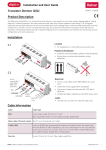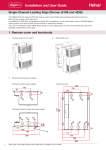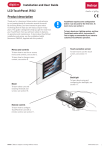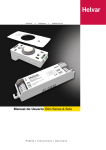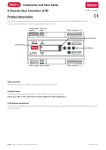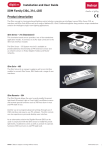Download Introduction 4 Channel DALI Ballast Controller (474) Installation and
Transcript
Installation and User Guide 4 Channel DALI Ballast Controller (474) Introduction The Digidim 474 is a 4-channel ballast controller fitted with high-inrush relays rated at 16 A per channel, which handle short, high peak currents during switch-on of loads. The 474 has an intuitive LED segment display and push buttons known as the ’Control Panel’, for monitoring, manual configuration and control purposes. The outputs can be configured to match common ballast control loads including 1–10 V, DSI®, DALI-broadcast and PWM. The Control Panel comprises: The outputs can be configured independent of, or paired with a relay channel. The 474 ballast controller can operate with either a Helvar Digidim or Imagine lighting control system and is DIN-rail mounted for ease of installation. • A 3-digit, 7-segment LED display (normally showing device activity) • Two buttons (‘up’ and ‘down’) to the right of the display, to view and configure parameters Control panel Installation 1 2 S-DIM / DMX Override Ballast Outputs 1 2 3 4 Status Display Mains Supply Location • For installation in a restricted access location only DALI Position & Ventilation 1 2 3 4 Relay Terminals Electrical • Do not connect DALI and S-DIM / DMX at the same time • Isolate the mains supply before installation • Install the unit horizontally to allow for heat dissipation • The external supply must be protected: 6 A MCB max. • Any enclosure must provide adequate cooling ventilation • All DALI and Mains cabling must be 230 V mains rated Cable Cable Type DALI 2-wire mains-rated. 0.5 mm² to 1.5 mm² Max. length 300 m (with 1.5 mm² cable). Example: Belden 8471 Mains cable / Dimmed outputs Max. 2.5 mm² stranded (4 mm² solid). S-DIM / DMX Low loss RS485 Type (multistranded, twisted and shielded). Note: One twisted pair for A and B (85 Ω to 100 Ω impedance), one core or twisted pair for 0 V, and shield for screen. Size: 0.22 mm² to 1.5 mm². Core: 3 or 4 + Screen. Max. Length 1000 m (lowloss cable). Example: Belden 8102 or Alpha 6222C Override 2-wire. 0.5 mm² to 1.5 mm². Max. cable length 50 m Helvar | Data is subject to change without notice. www.helvar.com i Contents SectionPage Introductioni Installationi Connections1 ii Power Up 2 Understanding the Status Display 2 Navigating the 474 Menu 3 Configuring the 474 4 Troubleshooting and Error Messages 5 DALI Physical Selection 6 Quick Start Guide 7 Technical Data 8 Helvar | Data is subject to change without notice. www.helvar.com Connections S-DIM / DMX TERM B SC 0V L N OVERRIDE A E SC 0V OVR C0 DA- DA+ Mains Supply 1 C1 1 DALI Mains Supply & DALI Mains Supply C0 2 2 Ballast Outputs C2 C0 Relay Outputs 3 C3 C0 3 4 C4 4 Override DALI Vin < 1.5 V Screen (if required) Ishort = 1 mA SW Close switch to cause level override DALI Devices Note 1: Functional earth connection used for DALI / S-DIM / DMX screens only Note 2: Do NOT connect DALI and S-DIM/DMX at the same time S-DIM / DMX Note: Maximum cable length = 50 m Relay Outputs 1 to 4 ii i Mains Supply S-DIM or DMX i iii i Input for override Note: Functional earth connection used for DALI / S-DIM / DMX screens only Lamps = S-DIM or DMX Data Cable (from previous device) ii = S-DIM or DMX Data Cable (to next device) iii= Link for Termination (if unit is at end of S-DIM/DMX cable line) Note: Keep unscreened wire lengths to a minimum Helvar 474 4 Channel Ballast Controller: Installation and User Guide Doc. 7860244, issue 4, 2014-08-28 1 Power Up During power up, the following sequence is displayed on the LED Control Panel. Each display is held for one second. At the end of this sequence, the ‘Status’ display appears. Start-up Sequence: 1. All segments on 0.5 sec 2. Product model 4. Normal Operation (Status Display) 3. Software version 0.5 sec 0.5 sec Understanding the Status Display The ’Status’ display is the default view in operation. It is the starting point for navigating and configuring the 474. ‘Power’ indicator S-DIM / DMX activity indicator ‘Up’ button ‘Down’ button Output mimics: 1, 2, 3 & 4 Software override indicator Key and LED Descriptions: Hardware (wired) override indicator ‘Power’ indicator Software override indicator The ‘power’ indicator (top segment of the middle digit) is always on when the 474 status display is active. The decimal point on the left is illuminated to indicate software override from the 910 / 920 router. The middle segment of the display will also flash. S-DIM / DMX activity indicator The S-DIM / DMX activity indicator (centre segment of the middle digit) is normally off, and flashes on intermittently if any S-DIM / DMX activity (communications) is directed to a channel within the ballast controller. Output mimics The output mimics (1, 2, 3 and 4) are illuminated when the relays/outputs are on, and not illuminated when the relays/ outputs are off. 2 DALI power / activity indicator Helvar 474 4 Channel Ballast Controller: Installation and User Guide DALI power / activity indicator The DALI indicator (bottom segment of the middle digit) is off if there is no DALI power, and on if DALI power is present. If any DALI activity is directed to a channel within the device, the indicator blinks off. Hardware (wired) override indicator The decimal point on the right is illuminated to indicate wired override. The middle segment of the display will also flash. Doc. 7860244, issue 4, 2014-08-28 Navigating the 474 Menu The status display LEDs on the front of the unit are lit in the following way when power is on: Navigate through the 474 menus using the up / down push buttons located on the front of the unit. Navigate the 474 menu to configure the unit. Cycle through the menu: 1) Press both buttons simultaneously to cycle through the menus. Tip! To cycle through the menus quickly, hold down both buttons. Select the desired channel to modify: 2) At your chosen function, quickly press up or down button to scroll through the channel destinations. These are the channels which will be affected by the following settings: Note: Select ‘ALL’ to alter all channels simultaneously. Modify function settings: 3) Hold up or down buttons to alter the levels, settings, fade times, output modes (dependent on function activated). + See section 7 for further details. - Note: LEDs blink if the value has been changed and not yet stored. Save changes: 4) Hold both buttons together to save the change. The LEDs will show 888 for 1 second to confirm setting is stored. Back To Previous Menu To go back to the previous menu, do not touch the buttons for 5 seconds. 5 sec Back To Status Display 10 seconds of inactivity returns the 474 to the Status Display screen. Tip! You can also return to the status display by cycling through all the menus. Helvar 474 4 Channel Ballast Controller: Installation and User Guide 10 sec Doc. 7860244, issue 4, 2014-08-28 3 Configuring the 474 Various settings can be configured via the control panel. Status Display / Set Channel Level Set Channel Levels (0 % – 100 %) by using the push buttons in ‘Status’ menu. Select the channel(s) to change, then hold the up or down button to alter levels. For further information, refer to the ‘Quick Start Guide’ in Section 10. Note:You can access ‘Status Display / Set channel level’ mode whilst the device is in override mode, but it is not possible to change the channel levels. Set S-DIM / DMX Address Set the S-DIM or DMX address for each channel. Select bAS to set the S‑DIM or DMX base address. S-DIM: 252 addresses available. DMX: 512 addresses available. Note: DMX updates are disabled while using manual control. Set DALI Address Set the DALI address for each channel. Select bAS to set the DALI base address. DALI: 64 addresses available. Enable/Disable DMX Enable or disable DMX from this menu. When DMX is enabled (‘On’) it will use the S-DIM address. There is no channel select option; it is a global setting. Note: DMX is disabled by default. Output Table Selection The outputs can be configured to match common ballast control loads via the ‘Output Table Selection’ (‘’) menu. See table below for a brief summary of output types. For further output information please see page 7. Output Output Type Standard information t 0 0 / 10 V Switched. OFF = 0 V ; ON = 10 V t t t t 1 - 10 sink EN 60929 Annex E, analogue control 0 - 10 V source ANSI E1.3 analogue control PWM+ Complement signal to PWM- control PWM- EN 60929 Annex E / JIS C8120-2 Appendix E DALI broadcast EN 60929 Annex E DSI Tridonic™ version 2 1 2 3 4 t 5 t 6 ® Minimum Fade Time Set the minimum fade time for the channels. Select the minimum fade time for each channel individually or ALL channels simultaneously. Minimum fade time can be set to: 1.00 second, 0.50 seconds, 0.15 seconds and 0.02 seconds. 4 Helvar 474 4 Channel Ballast Controller: Installation and User Guide Doc. 7860244, issue 4, 2014-08-28 Channel Pairing The output and relay channels are paired by default in a simple, one-to-one format. Configure the pair, or separate (‘SEP’) the channels as required. Note:Currently it is not possible to set channel pairing using Designer software. All channel pairing must be manually configured at the device. Override Level The override level can be configured for individual relay channels or ALL channels and ranges from 0 to 100. It can be manually tested via the override test function (‘Ort’) Note 1:When S-DIM/DMX is connected, the override settings in the router (configured using Designer software) will take precedence over the device’s override settings, unless you configure the software to use the device override settings. Note 2:When the unit is running in override, the left decimal point is illuminated and the middle digit of the screen flashes in the status screen. Override Test Test that the override level (set in the previous mode) functions as required, by choosing ON or OFF. The unit performs as if an override has been caused by the override input connection. Note 1:By switching this setting to ON it will not be possible to manually edit the channel levels in ‘Status Display / Set Channel Level’ menu. Note 2:To change the channel levels, ensure that override is switched off. Restore to Factory Default Hold the up or down buttons for 10 seconds in this menu. The decimal points will light up in sequence, and then all LEDs will be on for 1 second to confirm that factory settings have been restored. Note:Restore to Factory Default will cause all existing manually configured settings to be lost. Troubleshooting and Error Messages If an error occurs, please contact Helvar Support (see www.helvar.com for details). These details may be of assistance should an error message be displayed: Communications Error (S-Dim/DMX only) ErC indicates a problem with the S-DIM or DMX communications. Please check wiring and terminations. Make sure no two channels have the same addresses on the network, and that the S-DIM / DMX mode is selected correctly. Outputs Error Er0 indicates a problem with the output stages. Please contact Helvar Support for assistance. Important considerations • Do not connect DALI and S-DIM / DMX at the same time. • If DMX does not work then please check that it has been switched on in the dMX enu. Then it is possible to set the DMX addresses in the Ads menu. See page 6 for further information. Helvar 474 4 Channel Ballast Controller: Installation and User Guide Doc. 7860244, issue 4, 2014-08-28 5 DALI Physical Selection Physical selection mode is activated using a Helvar remote control unit. It allows loads and controls to be grouped together without the use of programming software. Refer to the equipment instructions for details. Follow these steps to use the module to identify a piece of equipment using physical selection mode. Note 1:Use the Remote Control Handset, with a Digidim control device, to put the device into ‘Physical Selection’ mode. Refer to the ‘ Digidim Lighting Control – Designing, Specifying and Installing’ System Manual (doc. no. 7860038), section 5 - 7 Physical Selection. Note 2:The ‘Physical Selection’ display is identical to the ‘Status Display / Set Channel Level’ display, except for the decimal point flashing. 1. Put the device into physical selection mode. The centre decimal point on the display screen flashes, which indicates that the device has entered ‘Physical Selection’ mode. 2. From the control panel, repeatedly press ‘up’ or ‘down’ button to scroll between channels. 6 The selected channel mimic (s) flashes. 3. To physically select the channel, hold the ‘up’ or ‘down’ button. The centre decimal point stops flashing for 2 seconds to indicate a successful programming. 4. Repeat step 2 and 3 for each channel, as necessary. 5. End ‘Physical Selection’ mode (at the device). You are returned to the ‘Status display. Helvar 474 4 Channel Ballast Controller: Installation and User Guide Doc. 7860244, issue 4, 2014-08-28 Helvar 474 4 Channel Ballast Controller: Installation and User Guide Return to Status Mode Restore to Factory Default Override Test Override Level Channel pairing Fade Time Output mode selection Enable DMX Set DALI Address Set S-DIM or DMX Address Status / Set Channel Level 474 Power On + 10 seconds - + - + - + - + - + - + See ‘Output table’ (on this page) - + - + - - + All LEDs flash. Reset complete. When desired level has been set, wait 1 second for status screen to reappear. + Hold both buttons together to store the setting. Hold up or down button to alter the levels, settings, fade times, output modes (dependent on active mode). PWM + PWM - t 3 t 4 Notes Variable level notice A UAr level notice occurs in certain modes if you are changing levels for ALL channels (via the ALL function) but the individual channel levels vary. Separate channel In ChP, select SEP to separate the selected paired channel Set DALI or S-DIM/DMX base addresses From the Add menu, select bAS to set the DALI base address. From the AdS menu, select bAS to set the S‑DIM or DMX base address. Select ALL channels Where available, select, ‘ALL’ to set all available channels. DSI® 0 - 10 V source DALI broadcast 1 - 10 V sink t 2 t 6 0 - 10 V [Switched. OFF = 0 V ; ON = 10 V] t 0 t 1 t 5 Output type Output Output table 10 seconds Back to status display - Press up or down button to scroll through the channel destinations. Press both buttons at the same time to cycle through the menu. Navigation Quick Start Guide Doc. 7860244, issue 4, 2014-08-28 7 Technical Data Connections Mains/relay/output: Mechanical data Solid core: up to 4 mm² Stranded: 2.5 mm² Dimensions: 100 mm × 160 mm × 45 mm Stranded: 2.5 mm² Housing: DIN-rail case; 9U Weight: 280 g IP code: IP30 (IP00 at terminals) Mains: 0.5 mm² – 1.5 mm² (max. 300 m @ 1.5 mm²) S-DIM / DMX: 0.22 mm² – 1.5 mm² low-loss RS485 Type (multistranded, twisted and shielded Power Mains supply: 85 VAC – 264 VAC 45 Hz – 65 Hz Power consumption: 2.4 W (min) to 11 W (all outputs fully loaded) Power circuit protection: 6 A MCB maximum The external supply must be protected DALI consumption: Inputs 2 mA Communication: DALI, S-DIM and DMX Override: Wired override input User interface: 2 push buttons for configuration Conformity and standards Emission: EN 61000–6–3 Immunity: EN 61547 Safety: EN 60950 DALI: According to DALI standard IEC 62386, with Helvar additions S-DIM: According to Helvar S-DIM protocol DMX: According to DMX512-A protocol Isolation: 4 kV between every connector (apart from common C0 ballast output terminals and S-DIM and Override connectors) Environment: Complies with WEEE and RoHS directives Outputs Source 10 mA 1–10 V: Sink 100 mA DALI / DSI®: (50 ballasts): Source 100 mA PWM +/- : (50 ballasts): Source 100 mA Relay contacts Channels: 4 Relay contacts: High inrush (200 µs at 800 A), single pole normally open (SPNO) Max. load per contact: 16 A resistive / incandescent; 10 A HID (cos y = 0.6) Number of devices: For ballasts, quantity is limited by MCB, refer to manufacturer’s data. Relay circuit external protection must not exceed 16 A type C MCB. Dimensions 100 mm 0–10 V: Operating and storage conditions 8 Ambient temp: 0 °C to +40 °C Relative humidity: Max. 90 %, non-condensing Storage temp: –10 °C to +70 °C Helvar 474 4 Channel Ballast Controller: Installation and User Guide Doc. 7860244, issue 4, 2014-08-28










